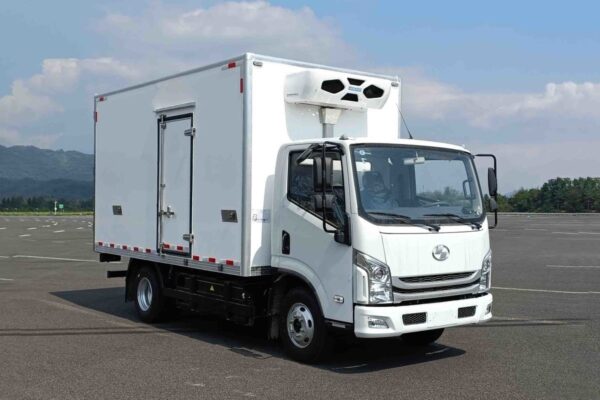የኤሌክትሪክ መኪና እውቀት
New Energy Vehicle Motor Testing
1. Introduction
In the burgeoning field of new energy vehicles, motor testing stands as a cornerstone in ensuring the quality, አፈጻጸም, and safety of these vehicles. As the global automotive industry is rapidly shifting towards electrification, both vehicle manufacturers and component suppliers are under increasing pressure to meet stringent testing requirements. In China, the access requirements for new energy vehicles clearly stipulate that vehicle manufacturers must possess the capabilities for integrated testing of power systems, drive systems, and control systems, as well as functional testing of electronic and electrical control systems. For component manufacturers, the ability to conduct testing and development in this area is also of utmost importance, including type tests and factory – out tests.
2. Significance of Motor Testing
2.1 For Vehicle Manufacturers
Motor testing is crucial for vehicle manufacturers as it directly impacts the overall performance and reliability of new energy vehicles. A well – tested motor can ensure smooth driving experience, high – efficiency power conversion, and long – term durability. By conducting comprehensive motor tests, vehicle manufacturers can optimize the integration of motors with other vehicle components, such as the battery system and the control system. This integration is essential for achieving better energy management, improving vehicle range, and enhancing overall safety features. ለምሳሌ, accurate testing of the motor’s torque and speed characteristics can help in fine – tuning the vehicle’s acceleration and deceleration performance, providing a more comfortable and responsive driving experience for the users.
2.2 For Component Manufacturers
Component manufacturers, በሌላ በኩል, rely on motor testing to demonstrate the quality and performance of their products. Meeting the testing requirements not only ensures that their motors can be used in new energy vehicles but also helps them gain a competitive edge in the market. Through rigorous testing, component manufacturers can identify potential design flaws and manufacturing defects early in the development process. This allows them to make necessary improvements, reducing the risk of product recalls and warranty claims. በተጨማሪም, high – quality testing results can enhance the brand reputation of component manufacturers, attracting more business opportunities from vehicle manufacturers.
3. Testing Standards
The testing standards for motors and controllers used in electric vehicles follow the national standard “GB – T18488 Electric Vehicle Motors and Their Controllers”. This standard comprehensively defines a series of test items to ensure that the motors and controllers can meet the demanding requirements of electric vehicle applications.
3.1 General Performance Testing
General performance testing includes evaluating basic parameters such as the rated power, rated voltage, and rated current of the motor. These parameters are fundamental to understanding the motor’s normal operating conditions and its ability to meet the power requirements of the vehicle. ለምሳሌ, the rated power determines the maximum power output the motor can provide under normal circumstances, which directly affects the vehicle’s driving performance, such as its maximum speed and acceleration capabilities.
3.2 Environmental Testing
Environmental testing subjects the motor and controller to various environmental conditions, including high – የሙቀት መጠን, low – የሙቀት መጠን, humidity, and vibration. In real – world applications, electric vehicles may operate in extreme climates, from the sweltering heat of deserts to the freezing cold of polar regions. Environmental testing helps to assess the motor’s and controller’s ability to withstand these harsh conditions without significant performance degradation. ለምሳሌ, a high – temperature test can simulate the operation of the vehicle in a hot summer day, checking if the motor can maintain its normal performance without overheating or suffering from component failures due to thermal stress.
3.3 Temperature Rise Testing
Temperature rise testing is essential to measure the increase in temperature of the motor during operation. Excessive temperature rise can lead to reduced efficiency, accelerated component aging, እና የደህንነት አደጋዎችም እንኳ. By precisely measuring the temperature rise under different operating conditions, manufacturers can optimize the motor’s cooling system design. This may involve adding more efficient heat – dissipating fins, improving the coolant circulation, or using better – heat – conducting materials to ensure that the motor operates within a safe temperature range.
3.4 Motor Torque and Efficiency Testing
Motor torque and efficiency testing focuses on evaluating the relationship between the torque output and the input power of the motor. ጉልበቱ – speed curve is a crucial parameter that reflects the motor’s ability to provide the necessary driving force at different speeds. ከፍተኛ – efficiency operation is also highly desirable as it directly impacts the vehicle’s energy consumption and driving range. By accurately measuring the motor’s torque and efficiency, manufacturers can optimize the motor’s design and control strategy to achieve better energy – saving effects. ለምሳሌ, a more efficient motor can convert a higher percentage of the electrical energy from the battery into mechanical energy, reducing the overall energy consumption of the vehicle and increasing its driving range.
3.5 Regenerative Energy Feedback Characteristics Testing
Regenerative energy feedback characteristics testing assesses the motor’s ability to convert the vehicle’s kinetic energy into electrical energy during braking or deceleration and feed it back to the battery. This feature is one of the key advantages of electric vehicles as it can improve energy utilization efficiency. Through this testing, manufacturers can evaluate the effectiveness of the regenerative braking system, including the amount of energy that can be recovered, the speed of energy recovery, and the impact on the vehicle’s braking performance. Optimizing the regenerative energy feedback characteristics can not only increase the vehicle’s range but also reduce the wear and tear of the traditional braking system.
4. Main Test Contents
4.1 No – load Test
The no – load test is carried out when the motor is running without any external load. During this test, parameters such as the no – load current, no – load power, and rotational speed are measured. The no – load current and power consumption can reflect the quality of the motor’s internal components, such as the stator and rotor. Abnormal no – load current or power consumption may indicate problems such as improper winding, bearing friction, or magnetic circuit leakage.
4.2 Load Efficiency Test
The load efficiency test is designed to measure the motor’s efficiency under different load conditions. By applying various loads to the motor and measuring the input power and output mechanical power, the efficiency curve of the motor can be obtained. This curve provides valuable information about the motor’s performance at different operating points, helping manufacturers to optimize the motor’s operation and select the most suitable operating conditions to achieve high – efficiency operation.
4.3 Locked – rotor Test
The locked – rotor test is a critical test that simulates the situation where the motor’s rotor is suddenly locked. During this test, the locked – rotor current and torque are measured. These parameters are important for evaluating the motor’s starting performance and its ability to withstand short – term overload conditions. A high – quality motor should be able to handle the locked – rotor situation without suffering from excessive current draw or component damage, as this situation may occur during abnormal driving conditions or when the motor is starting under heavy loads.
4.4 Motor Temperature and Temperature Rise Monitoring
Continuous monitoring of the motor’s temperature and temperature rise during operation is essential. Temperature sensors are installed at key positions within the motor to accurately measure the temperature. ቀደም ሲል እንደተጠቀሰው, excessive temperature can have a significant impact on the motor’s performance and lifespan. By closely monitoring the temperature and temperature rise, manufacturers can ensure that the motor’s cooling system is working effectively and take timely measures if the temperature exceeds the safe range.
4.5 Overload Capacity Test
The overload capacity test evaluates the motor’s ability to operate under overload conditions for a certain period. This test is important as electric vehicles may encounter situations where the motor needs to provide additional power, such as when climbing steep slopes or accelerating quickly. The motor should be able to withstand a certain degree of overload without significant performance degradation or damage. During the test, the motor is loaded beyond its rated capacity, and parameters such as the current, የሙቀት መጠን, and torque are monitored to assess its overload performance.
4.6 Maximum Operating Speed Test
The maximum operating speed test determines the highest rotational speed that the motor can reach under normal operating conditions. This parameter is crucial for ensuring the safety and performance of the vehicle. Exceeding the maximum operating speed can lead to mechanical failures, such as bearing damage, rotor imbalance, or even the disintegration of the motor. By accurately measuring the maximum operating speed, manufacturers can set appropriate speed limits and control strategies to ensure the safe operation of the motor.
4.7 Over – speed Test
The over – speed test is a more extreme test that subjects the motor to speeds higher than its maximum operating speed for a short period. This test is used to evaluate the motor’s mechanical strength and its ability to withstand high – speed operation under abnormal conditions. The motor is gradually accelerated to the over – speed level, and its performance and structural integrity are closely monitored. If the motor can withstand the over – speed test without any visible damage or abnormal behavior, it indicates that the motor has sufficient mechanical strength and safety margins.
4.8 Motor Controller Protection Test
The motor controller protection test focuses on evaluating the various protection functions of the motor controller, such as over – current protection, over – voltage protection, and under – voltage protection. These protection functions are essential for safeguarding the motor and the controller from damage under abnormal operating conditions. ለምሳሌ, if the motor experiences a sudden short – circuit, the over – current protection function of the controller should be able to quickly cut off the power supply to prevent excessive current from flowing through the motor and causing damage to its components.
5. Common Motor Testing Systems
5.1 Dynamometer System
The dynamometer system is a widely used motor testing system. It mainly consists of a front – end power – supply test DC power supply (battery simulator), a dynamometer, an inverter, and the necessary instruments and meters for testing. The battery simulator is used to simulate the output characteristics of the vehicle’s battery, providing the necessary electrical energy for the motor. The dynamometer is the core component of the system, which can apply different loads to the motor and measure its torque, ፍጥነት, and power output. The inverter is used to convert the DC power from the battery simulator into AC power suitable for the motor’s operation. The instruments and meters, such as current sensors, voltage sensors, and power analyzers, are used to accurately measure the electrical parameters of the motor during the test.
5.2 Motor Towing – pair Testing System
The motor towing – pair testing system is another common testing solution. It includes a front – end power – supply test DC power supply (battery simulator), a companion motor and its electronic control unit, and the required instruments and meters. In this system, the companion motor is used to simulate the actual load of the motor under test. By adjusting the operation of the companion motor, different load conditions can be created for the motor under test. The battery simulator provides the electrical energy for both the motor under test and the companion motor. The electronic control unit of the companion motor is responsible for controlling its operation and ensuring that it can accurately simulate the load characteristics. This system is especially useful for testing the motor’s performance under different load – torque relationships and for evaluating the interaction between the motor and its load.
6. Requirements for Power Supplies in Testing Devices
The power supply part of the motor controller in the testing device can be in the form of a two – quadrant DC power supply or a combination of a DC power supply and a DC load. The performance and reliability of the power supply part directly determine the experimental capabilities of the system. ስለዚህ, the following requirements are imposed on the power supply:
6.1 Fast Dynamic Response Characteristics
The power supply should have fast dynamic response characteristics, such as rapid response to sudden load changes (sudden loading, sudden unloading, and charge – discharge conversion). ለምሳሌ, in the IT6500 series of ITECH, the minimum voltage rise time can reach up to 3ms, which can meet the requirements of various operating conditions. This fast response is crucial as electric vehicles often experience rapid changes in power demand during acceleration, deceleration, and regenerative braking. A power supply with slow response may cause voltage fluctuations, affecting the accuracy of the test results and potentially causing damage to the motor and controller.
6.2 High Reliability, Stability, and Conversion Efficiency
High reliability and stability are essential for the power supply to ensure the accuracy and repeatability of the test results. Power supply failures during testing can lead to inaccurate data and wasted testing time. ITECH Electronics has a wide range of power supply and load product lines and testing system products, which have obvious advantages in product stability and reliability. በተጨማሪም, high conversion efficiency is desirable as it can reduce energy consumption during the testing process, saving costs and reducing the environmental impact. A power supply with high conversion efficiency can convert a larger proportion of the input electrical energy into useful output energy, minimizing energy losses in the form of heat.
6.3 High Output Accuracy
The power supply should have a high output accuracy. In the IT6500 series, the maximum voltage accuracy can reach 0.05% + 30mV, which can easily meet the accuracy requirements of the testing system. Precise control of the output voltage and current is crucial for accurate testing of the motor’s performance parameters. ለምሳሌ, when measuring the motor’s efficiency under different load conditions, even a small deviation in the power supply’s output voltage or current can lead to significant errors in the calculated efficiency values.
6.4 Two – quadrant Characteristics
The power supply should have two – quadrant characteristics, enabling it to absorb the electrical energy fed back by the motor. The IT6500C DC power supply equipped with a power dissipator has a seamless two – quadrant switching function, effectively avoiding voltage or current overshoots. This is particularly important during regenerative braking, where the motor acts as a generator and feeds electrical energy back to the power supply. A power supply without two – quadrant capabilities may not be able to handle this regenerative energy, resulting in voltage spikes or instability in the testing system.
6.5 Meeting Standard Requirements for Power Supplies in Motor and Controller Tests
The power supply should meet the requirements for power supplies in motor and controller tests specified in the standards. It should conform to the voltage – current characteristics of vehicle – used batteries, and the output impedance of the power supply should be as close as possible to the battery impedance. The IT6500C DC power supply has an adjustable output impedance function, which can more accurately match the battery simulation requirements compared to ordinary DC power supplies. This accurate impedance matching is crucial for simulating the actual operating conditions of the motor in a vehicle, ensuring that the test results are more representative and reliable.
7. ማጠቃለያ
New energy vehicle motor testing is a complex and multi – faceted process that involves strict testing standards, diverse test contents, and advanced testing systems. Both vehicle manufacturers and component manufacturers need to attach great importance to motor testing to ensure the quality and performance of new energy vehicles. The continuous improvement of testing technologies and the development of more advanced testing equipment, such as high – performance power supplies, will further promote the development of the new energy vehicle industry. As the demand for new energy vehicles continues to grow, the accuracy and reliability of motor testing will play an increasingly crucial role in ensuring the safe and efficient operation of these vehicles and in meeting the ever – increasing expectations of consumers.




